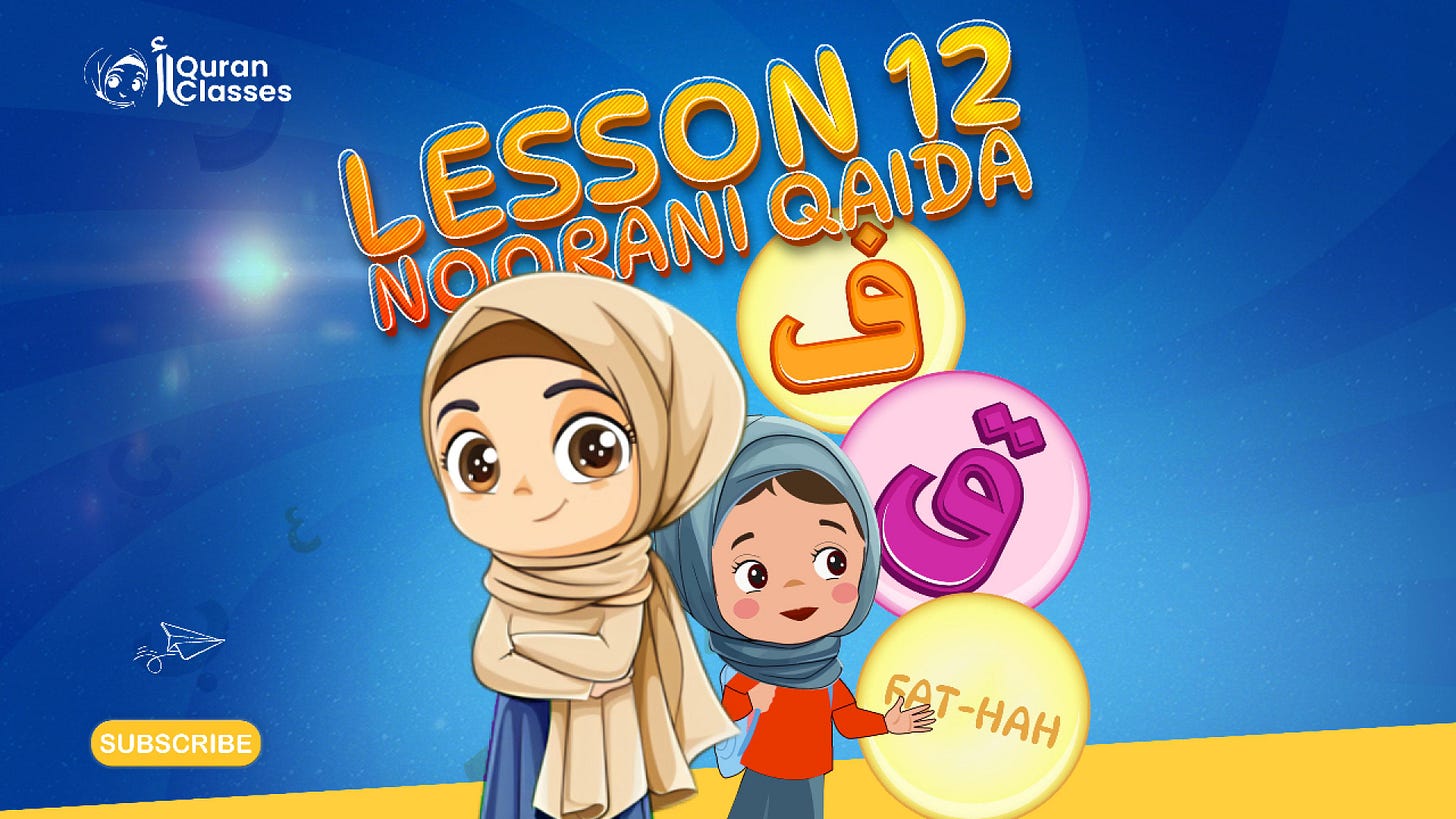Bayt Al-Quran: Noorani Qaida-Lesson#12|Friday
Learning the Letters فَ (Faa) and قَ (Qaaf) with Fathah
Dear Learners, Today, we’re about to meet two new friends from the Arabic alphabet—ف (Faa) and ق (Qaaf)!
Let’s imagine: if letters could talk, ف (Faa) would have a soft, friendly voice—like someone gently blowing out a candle. Try it—just a small f sound, like “ffff”. That’s Faa, smooth and easy.
Now, get ready for ق (Qaaf)—a deeper, stronger sound that comes from the back of your throat. It's bold and powerful, like a knight saying "Qaf!" with pride.
Each of these letters has its own special way of sounding and looking. And just like the letters we’ve already learned, they’ll also change shape a little when they join hands with other letters in a word.
Are you ready to explore ف and ق together? Let's go find their secrets—how they look, how they sound, and how they live in words!
Key Learning Points for the Letters فَ and قَ:
Introduction to the Letters فَ and قَ with Fathah ( َ ) – A focused lesson designed to introduce children to the proper pronunciation and visual recognition of the Arabic letters فَ (Faa with Fathah) and قَ (Qaaf with Fathah), laying the groundwork for clear and correct Arabic reading.
Understanding Connected Letter Forms – Teaching how فَ and قَ connect with other letters in different word positions, helping learners identify these letters whether they appear at the beginning, middle, or end of a word.
Pronunciation and Writing Practice – Guided articulation and writing drills to help children master the correct pronunciation from the lips (Faa) and the deep throat (Qaaf), along with accurate writing strokes.
Repetition for Retention – Structured repetition exercises reinforce the unique sounds of فَ and قَ, ensuring students retain both pronunciation and recognition.
Interactive Learning with Flashcards – Colorful, themed flashcards help children associate each letter with familiar images and words, making learning enjoyable and memorable.
Building Words with Learned Letters – Practice sessions combining فَ and قَ with previously learned letters to form and read new words, strengthening fluency and confidence.
Word Recognition Activities – Engaging recognition games and activities that help children quickly spot فَ and قَ within Arabic words, enhancing their reading ability.
Story-Based Learning – Simple, short Arabic stories featuring فَ and قَ, supported by English translations, help children understand word usage in context while expanding their vocabulary.
Homework and Practice Worksheets – Take-home worksheets with tracing and reading exercises give children a chance to reinforce what they’ve learned and build consistent practice habits.
🎥 Watch Today’s Lesson Video:
Ready to Master Faa & Qaaf?
Let’s Go!
Print your activity sheet, grab some crayons or markers, and dive into a fun learning session! These two letters may seem alike, but with a little practice, you'll tell them apart with ease. Just a few minutes a day can turn tricky letters into familiar friends—let’s make Quran time exciting!
Play Time:
1. 🥁 Faa & Qaaf Sound Band
Turn your child into a one-person sound band!
ف (Faa) = light table tap (like a flute)
ق (Qaaf) = deep floor thump (like a drum)
Say these aloud together while tapping out the beat:
فَ قَ فُ قُ فِ قِ
Then challenge them to make their own beat using ف and ق syllables.
2. 🦶 Letter Hop Adventure
Place two pieces of paper on the floor: one with ف, one with ق.
Say a word (real or made-up).
Your child must jump to the right letter depending on which sound starts the word.
Example:
“فيل (feel)” → jump to ف
“قطار (qitaar)” → jump to ق
You can even make it sillier by adding animal sounds as clues!
3. 🧃 Sip & Say
Give your child two straws—one thin and one wide.
Ask them to sip water through both and describe the difference.
Then say ف and ق after each sip.
Talk about how:
ف feels like sipping gently through the thin straw.
ق feels like blowing forcefully through the thick straw.
Great for teaching mouth pressure and sound control!
4. 🎭 Character Talk Time
Ask your child to invent two characters:
Fuzzy Faa – gentle, soft, maybe likes flowers
Captain Qaaf – bold, brave, and loud
Have them:
Describe what each character sounds like
Roleplay a tiny conversation using words like فيل and قمر
You can even record it as a voice skit to play back and send it to us!
We’d Love to Hear from You
How did Lesson#12 go for your child? Share your feedback in the comments or upload a photo of their worksheet. Teacher Noura will review it and leave a kind note, inshaAllah.
Your child’s adventure with Arabic letters is growing wonderfully. Keep up the great work, and we’ll see you again soon for another fun-filled lesson!



